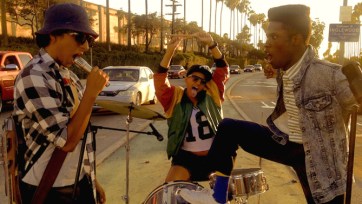GBN In JULY

It’s here! Summer… and man, is there is a lot going on in the world. So if you just want some time to pause and do something fun alone or with loved ones, check out a few things happening this month. Personally I am looking forward to the Sneaker Exhibit. Enjoy July!
IN CINEMA
ME AND EARL AND THE DYING GIRL
Rated PG-13 –NOW PLAYING

If you just want to catch a really great flick…. Me and Earl and The Dying Girl “lives” up to the hype. (Yes, I’ve seen it, and yes, I’ve got a lot to say… GBN review coming soon.) Oh, and Earl is the greatest character I’ve seen in a while. Highly Recommend. Check out the trailer here: https://youtu.be/2qfmAllbYC8
DOPE
Rated R – NOW PLAYING

High-school senior Malcolm (Shameik Moore) and his friends Jib (Tony Revolori) and Diggy (Kiersey Clemons) bond over ’90s hip-hop culture, their studies and playing music in their own punk band. A chance encounter with a drug dealer named Dom lands Malcolm and company at the dealer’s nightclub birthday party; when the scene turns violent, they flee — with the Ecstasy that Dom secretly hid in Malcolm’s backpack. A wild adventure ensues as the youths try to evade armed thugs who want the stash.
Now playing check out the trailer here: https://www.youtube.com/watch?v=strEm9amZuo
SOUTHPAW
(Currently unrated) – RELEASE DATE JULY 24th

I just saw the trailer for this and I’m hooked. Gotta say… I am loving Curtis “50 Cent” Jackson in the acting game. Antoine Fuqua (“Training Day”) directs. Check out the trailer here: https://youtu.be/Mh2ebPxhoLs
IN MUSIC

July 8 – July 11, 2015 Brooklyn Hip Hop Festival: A celebration of Hip-Hop Culture and the Borough of Brooklyn Artists include: Common, Mobb Deep, Lion Babe, Freeway, Charles Hamilton, Pitch Blak Brass Band, Skyzoo, John Robinson, DJ Rob Swift, Torae, and “Uncle Ralph” McDaniels, http://www.bkhiphopfestival.com
July 10- October 4, 2015 Brooklyn Museum – catch the exhibition: “The Rise of Sneaker Culture” https://www.brooklynmuseum.org/exhibitions/rise_of_sneaker_culture/


July 18 – IRVINE, CA; July 19, 2015 – MOUNTAINVIEW, CA

Artists Include: The Game, Bone Thugs-N-Harmony, Ice T, Afrika Bambaataa and The Soulsonic Force, Big Daddy Kane, Rakim, Mack 10, Xzibit, Warren G, Rapper’s Delight, Kurtis Blow, Too Short, Doug E Fresh, DJ Quik, Kool Moe Dee, King T, Grand Master Melle Mel, Tha Alkaholiks, Biz Markie, Slick Rick, EPMD, Cold Crush Brothers, Ras Kass and other special guests. The event will be MC’d by Chief Rocker Busy Bee. https://www.facebook.com/artofrapfest
RELATED: Ice-T Breaks Down Why “Art of Rap” Festival in July is Important to Hip-Hop, Art & Music
July 30 – LOS ANGELES, CA

Thanks to my little sis, Ashley, I’m also recommending checking out the truly captivating musical artist-singer Moses Sumney. Check him out on SOUNDCLOUD: https://soundcloud.com/mosessumney
He’s headlining the Echo in Los Angeles on July 30th. http://www.theecho.com/event/861489-moses-sumney-los-angeles/venue/
IN ARTS
July 10-12 – DENVER, CO

The Colorado Black Arts Festival is excited to present the best of visual and performing arts to celebrate its 29th Annual Festival July 10-12, 2015 in historic Denver City Park West. This year’s Festival theme “Rock Steady” conveys the ability to excel in the arts with a rocking and soulful dimension. It represents a soulful genre that captures artistic rhythms with origins in the African diaspora. Rock Steady 2015! To learn more, go to: http://www.colbaf.org




 Anyway, many from the digital community have put the idea of racebending on its head by creating ethnic versions of their favorite characters from books, film and TV. It’s a fairly common practice among online artists. Julia, in particular, has gone on a run of re-doing Disney heroines with an Indian version of Rapunzel and a
Anyway, many from the digital community have put the idea of racebending on its head by creating ethnic versions of their favorite characters from books, film and TV. It’s a fairly common practice among online artists. Julia, in particular, has gone on a run of re-doing Disney heroines with an Indian version of Rapunzel and a 












